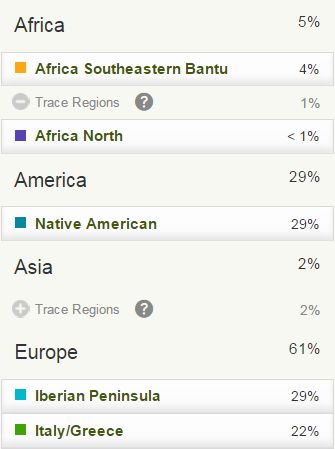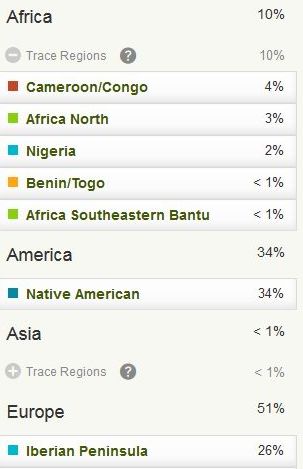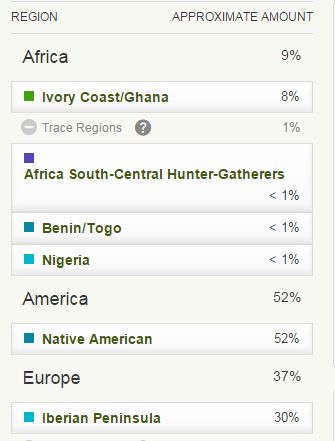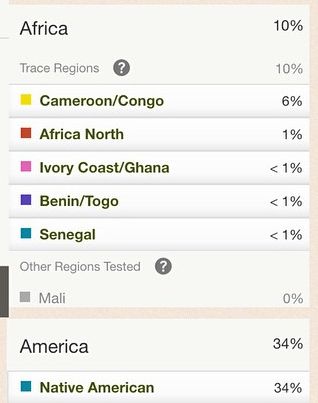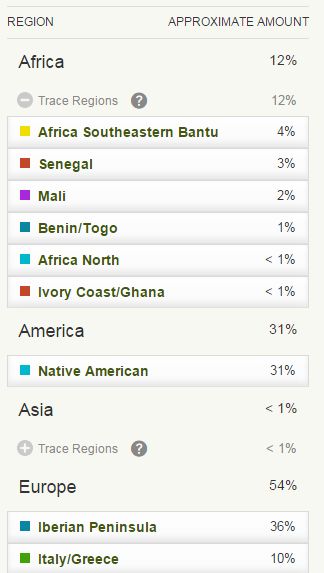On this page i will attempt to provide some analysis for the Latin American AncestryDNA results which have kindly been shared with me or which i found on public websites. The ones for Puerto Rico and the Dominican Republic are featured on separate pages. Due to limited samplesize i will mainly discuss the results from Mexico and Colombia. However i do also have some individual results to show from El Salvador, Guatemala, Honduras, Costa Rica, Bolivia and Venezuela. Not per se representative of course but already very insightful in themselves. If you want to skip the discussion just scroll to the bottom of the page to see a selection of Latin American AncestryDNA results. I will restrict myself to the African part of their Ethnicity Estimates as it’s in line with the theme of this blog. Even when it will only be a minor part of their total ancestry in almost all cases. In order to enable easy comparison i have therefore scaled the African breakdown to 100% for all, leaving aside any non-African ancestry. For more details on my research methodology see the front page of this AncestryDNA section. Follow this link for an overview of all the Latin American results:
Spreadsheet with Latin American results
As far as i was able to verify all of these Latin American results are from persons who are either born themselves in the specified country or who have two locally born parents from that country. These are obviously first of all individual results reflecting unique family trees and limited in number. Furthermore DNA testing at this stage cannot be expected to be 100% accurate in estimating regional origins. See this page for more disclaimers, especially on how the country name labeling of the AncestryDNA regions should not always be taken at face value. Undoubtedly with more Latin American testresults available you will see many more additional and different patterns. As obviously Latin America is a huge and diverse continent and even within countries there might be a great deal of wideranging variation and regional differentation. Not only in total amounts of African ancestry but also for within-Africa origins.
I suppose only the samplesize for the Mexican results (n=36) might be expected to give some preliminary indications about the main African regions present in the Mexican genepool. Actually i also included a few results from multigenerational Hispanos from New Mexico and Tejanos from Texas. Grouping them together with Mexican results was done purely for historical reasons and out of convenience, no other implications are intended. Naturally as my research was centered on only the African breakdown i didn’t include any results for people who had zero African to show or just minimal trace amounts. So in that way no fictional national averages are intended. Still i think the screenshots i will post in the last section of this page might be representative to a considerable degree for how many other people from the specified nationality would score hypothetically speaking. I will now proceed with discussing the main patterns i’m able to pick up on from the data. Of course merely expressing my personal opinions & thoughts and not meant to be conclusive in any way 😉
UPDATE
This article was first published on 8 Nov. 2015, when I only had a limited number of Latin American AncestryDNA results available for my analysis. As my survey has been ongoing I eventually managed to collect a much bigger samplegroup, incl. 96 Mexican AncestryDNA results in 2018. In 2020 I also published my survey findings based on Latin American 23andme results, incl. 49 Mexican results and 22 from Colombia.
Follow these links below for more recent analysis of Latin American genetics. Including preliminary substructure results based on making a distinction for the total level of African admixture (Cuba and Mexico). And also making a regional distinction (Andes, Caribbean, Pacific) for results from Colombia. Furthermore I also provide evenhanded comparison with other Afro-descended populations in the Americas.
- Update: Afro-Diasporan AncestryDNA Survey (part 1) (2018) (see also this total overview)
- Update: Afro-Diasporan AncestryDNA Survey (part 2) (2018)
- Hispanic 23andme results (2020)
p.s. keep in mind that AncestryDNA’s ethnicity estimates have been updated several times now! On this page I am dealing exclusively with AncestryDNA version 2 which was current between September 2013 and September 2018. All matters being discussed on this page are therefore not pertaining to updated results (2018 and onwards). See this page for an overview of all the updates Ancestry has performed in the last couple of years.
_____________________________________________________________________________
1) Summary of Findings
***(click to enlarge)
***
***
When reviewing the statistics i calculated above based on the data entered in the spreadsheet, it’s good to be aware that averages tend to hide underlying variation. That’s why it’s always advisable to also take into account other measures such as the median and also the minimum & maximum values to get a sense of the range of the scores.
***(click to enlarge)
***
The chart above features an additional macro-regional breakdown into “Upper Guinea”, “Lower Guinea” and “Central Africa” which is of my own making. Making this distinction is admittedly arbitrary and can only produce a rough proxy, given the limitations of AncestryDNA. Still I find it useful because you get to see some patterns more clearly and it conforms with what’s common in slave trade literature. For ethnolinguistical and historical maps from these 3 main regions of provenance see: Upper Guinea, Lower Guinea, Central Africa.
Observations
• First thing to emphasize is that most of the Latin Americans featured in my data are of minor African descent (<10%). The persons in my spreadsheet being mostly of mixed Amerindian and European descent or at times also predominantly of European descent. Oftentimes their African ancestry is being reported as Trace Regions only. In these cases the regional estimates given by AncestryDNA may perhaps be seen as less robust. However the most frequently appearing regions for my samplegroup are genetically rather distinct. “Senegal”, “Mali”, “North Africa” and “Southeastern Bantu” being on opposite sides of the African range. Therefore the reported estimates could still be of informative value. Furthermore the same regional patterns prove to be still consistent also when reviewing results of Latin Americans with higher than average African amounts, incl. 1 or 2 African regions mentioned above trace level. See also screenshots posted on the bottom of the page.
• Combining the Mexican and Central American results they display some of the most regionally distinct compositions in my survey (see also Afro-Diaspora AncestryDNA results: A Comparison). Aside from Cape Verdeans they are the only nationalities to show a majority of Upper Guinean (“Senegal” + “Mali”) ancestry in their African breakdown sofar. Even with especially the samplesize of Central American results being minimal it’s probably no coincidence that proportionally similar breakdowns are reported across borders. The historical involvement of these Meso American countries with the Trans Atlantic Slave Trade is unique when compared with other parts of the Americas. As it was both more restricted in timeperiods (mainly 1500’s/1600’s) and also limited in regional scope (mainly Upper Guinea and Angola). A socalled Upper Guinean founding effect can be observed to a lesser degree also among other Latin Americans however. As confirmed for Colombians, Hispanic Caribbeans, Hondurans and Mexicans in these DNA studies:
- Reconstructing the Population Genetic History of the Caribbean (Moreno-Estrada et al., 2013)
- Unravelling the hidden ancestry of American admixed populations. (Montinaro et al. (2015)
• The socalled “Mali” region shows up quite prominently for Mexicans, when calculated as an average ratio of total African ancestry. And also when compared with African Americans and West Indians this region peaks for Mexicans (see chart in next section). This outcome could be very meaningful for a better interpretation of the “Mali” scores across the Afro-Diaspora. As far as i know no genuine Malian origins (“Bambara”) have been documented in great numbers for Mexico or any at all. So it seems reasonable to assume that this region is indeed also pinpointing ethnic origins from outside Mali’s borders (as advised by Ancestry.com, see AncestryDNA regions). And in particular from either Guinea Conakry or Sierra Leone.
• Aside from a couple of outliers it seems sofar that ethnic origins from within the Ghana-Benin-Nigeria area are subdued for Mexicans and Central Americans. Especially when compared with other nationalities in my spreadsheet for whom Lower Guinea is usually the greatest combined source of their African ancestry. Instead especially for Mexicans Lower Guinea is the smallest (16%) of the three greater macro regions to be distinguished for Atlantic Africa. This would be conforming with what we know generally speaking about Africans arriving mostly in the 1500’s/1600’s in Mexico/Central America when Lower Guinea was not yet heavily visited by European slave traders. This is not say that captives from these parts were completely absent. Especially in the early 1700’s under English Asiento it is known some people from Ghana, Benin, Nigeria still arrived in Mexico and Central America. But in much decreased numbers compared with earlier periods as the need for slave labour was no longer acute by this time. “Ivory Coast/Ghana” and “Benin/Togo” are still appearing in rather high proportions among a few of my samples. One possible explanation (among others) might be intermarriage occurring in later timeperiods (1800’s/1900’s). Involving for example people from the Caribbean coastline of Central America which is known to have been much more influenced by the African lineages from Lower Guinea also prevalent in the Anglo-Caribbean.
• It is probably telling that sofar the averages for “Southeastern Bantu” are significantly higher than for “Cameroon/Congo”, especially for Mexicans and Colombians. This is in line with other Hispanic results i’ve seen but not so, generally speaking, for West Indians or African Americans. It could very well signal especially (but not exclusively) Angolan ancestry from the 1600’s. The slave trade carried out between Angola on the one end and Veracruz in Mexico and Cartagena in Colombia on the other end has been very well documented. Also for Mexico in particular an overwhelming predominance of Angolan slaves in colonial archives dating from the 1600’s has been described by several historians. In that sense these results are not surprising.
In light of this documentary evidence perhaps an even greater frequency of “Southeastern Bantu” scores might have been expected for Mexicans. However aside from the still limited samplesize we should also consider that Mexico did experience a previous Upper Guinean “wave” in the 1500’s. These Upper Guinean arrivals were also significant in numbers even if not as well documented. But perhaps more importantly this primary African geneflow occurred during a crucial timeperiod of Mexican demographics characterized by widespread miscegenation and dramatic decline of Amerindian populations. Ultimately it doesn’t matter how many Angolans or Upper Guineans entered Mexico in exact numbers, what matters is how many offspring they had and to what extent their descendants were absorbed by the evolving mixed-race “Mestizo” population. Either way it’s remarkable that both early waves of African origins seem to be so well detected by the AncestryDNA data.
• The “North African” scores are especially noticeable for Latin Americans of minor African descent otherwise. Other DNA testing companies usually classify this type of ancestry separately from socalled Sub Saharan African (SSA) ancestry. Hence why you might notice a difference in total African ancestry percentages when comparing for example between test results on Ancestry.com versus 23andme. Generally speaking these socalled “North African” DNA markers might mostly have found their way in Latin American bloodlines by way of either Iberian or Canarian settlers. Possibly indicating a Morisco legacy, partial Guanche ancestry or perhaps even dating from North African/Iberian connections during prehistorical times. As i am scaling everyone’s African breakdown to 100% this causes the “North African” proportions to appear inflated for people with little “SSA” ancestry otherwise (e.g. compare the proportional share of “North Africa” among Mexicans with that for Central Americans who have slightly higher total African). Based on the original percentages as provided by AncestryDNA, the average “North African” scores might still be rather consistent though across my entire samplegroup: about 2%. (see also this chart).
• Despite similarly high averages for “Southeastern Bantu” and to a lesser degree also “Senegal” and “Mali” the Colombian results are already showing some differentation when compared with the Mexican and Central American ones. This is to be expected as Colombia experienced a longer period of African geneflow generally speaking, also including significant origins from Lower Guinea in the 1700’s. Furthermore the overall racial composition of Colombia is more heterogenous than that for Mexico or Central America, including a much greater share of people of predominant African ancestry, a.k.a. Afro-Colombians. It should be noted however that among the Colombian samples i collected sofar the highest amount of African ancestry was only 26%. Similar to what i discussed for the Puerto Rican results there might very well be substructure in the regional African origins of Colombians correlating with their degree of total African ancestry. An additional differentiation might be found when establishing the average African breakdown for Colombians from the Caribbean coast as compared to the one for Colombians from the Pacific (Chocó) coast. Hopefully future research will be able to provide more insights by utilizing a more wideranging samplegroup from Colombia.
_________________________________________________________________________
2) African ancestry dating mostly from the 1500’s/1600’s?
***
African origins documented for Mexico during the 1500’s
(click to enlarge)
***
African origins documented for Mexico during the 1600’s
***
(click to enlarge)
***
African origins documented for Colombia (1579-1719)
(the ethnic groups are listed according to area: Upper Guinea, Lower Guinea and Central Africa)
(click to enlarge)

Source: “Génesis y desarrollo de la esclavitud en Colombia, siglos XVI y XVII.” (Navarrete, María Cristina. 2005)
***
Upper Guinean and Angolan “waves” for Cartagena (Colombia)
(click to enlarge)

Source: “THE AFRO-PORTUGUESE MARITIME WORLD AND THE FOUNDATIONS OF SPANISH CARIBBEAN SOCIETY, 1570-1640” , (D. Wheat 2009).
***
Documented slave voyages directly from Africa to Veracruz (Mexico) and Cartagena (Colombia)
(intercolonial slave trade via the Hispanic Caribbean is not included in these numbers)
***
(click to enlarge)

Source: “THE AFRO-PORTUGUESE MARITIME WORLD AND THE FOUNDATIONS OF SPANISH CARIBBEAN SOCIETY, 1570-1640” , (D. Wheat 2009).
***
Timeperiods when most Africans arrived in Veracruz (Mexico) and Cartagena (Colombia)
(intercolonial slave trade via the Hispanic Caribbean (1500’s/1600’s) & the West Indies (late 1600’s-1800’s) is not included in these numbers)
(click to enlarge)

Source: Trans-Atlantic Slave Trade Database (2010) (http://www.slavevoyages.org)
***
Highest “Senegal”, “Mali” and “Southeastern Bantu” averages on AncestryDNA
(click to enlarge)
***
(click to enlarge)
One of the most intriguing outcomes of my AncestryDNA survey for me personally has been the seemingly resounding confirmation of what might be called a founding effect from the earliest victims of Trans Atlantic Slave Trade (1500’s/1600’s). A clear majority of these persons arrived in the Hispanic Americas from the Upper Guinea region, often by way of Cape Verde and also from Central Africa by way of Angola, as can be seen in the charts above. Veracruz in Mexico and Cartagena in Colombia being the officially allowed main gateways of African captives during the Iberian Union (1580-1640), when the Portuguese and Spanish empires were temporarily united. In the preceding timeperiod (1492-1580) most of the African captives arrived primarily in the Hispanic Caribbean before being distributed elsewhere. It is astonishing to find out that the genetic legacy of these African pioneering co-builders of Hispanic colonial societies is still highly detectable and persistent. It seems to be a testimony to their survival skills and also their early integration in colonial populations.
We can verify this by reviewing the last two charts featuring AncestryDNA data. The averages for “Senegal”, “Mali” and “Southeastern Bantu” are significantly higher for all Hispanic nationalities when compared with African Americans and West Indians. This goes especially for “Senegal” which peaks for my Cape Verdean samples, corroborating its ultimate Upper Guinean origins. Looking for the highest averages among the Latin American nationalities covered by my survey it’s El Salvador where “Senegal” peaks, Mexico where “Mali” peaks and Colombia where “Southeastern Bantu” peaks. Obviously the samplesize is still quite minimal for most nationalities, however the same patterns are obtained when looking which African regions are ranked #1 most frequently for my 36 Mexican samples.
A similar finding was also reported by:
- Reconstructing the Population Genetic History of the Caribbean (Moreno-Estrada et al., 2013)
- Unravelling the hidden ancestry of American admixed populations. (Montinaro et al. (2015)
Lest i be misconstrued let me repeat that overall Latin Americans will of course show a much higher degree of diversity in African origins. Despite common ground between the various Hispanic countries there are also many locally distinct factors which lead to differentiation of their populations. Zooming in on their African origins a major determinant was obviously the historical extent of slave trade: how long did it last? in which timeperiod did it peak?, which African regions of provenance were involved? and to which extent were Africans absorbed in the mixed-race genepool by way of mestizaje? It could very well be that in many cases selfidentified “black”, “mulato” or “afromestizo” Latin Americans might show very different regional patterns. As a reflection of their African ancestry possibly dating from more recent timeperiods (1700’s/1800’s) on average. In this section i’m focusing on the results that were available to me, those of Mexicans and Colombians in particular. And naturally they are also both unique countries, each to be placed in its own context. Even when they along with many other Hispanic countries seem to share a founding effect from Upper Guinea and Angola in their African genes. It seems telling, despite limitations of data, that these founding effects are showing up to varying degree. With the most prominent and convincing cases sofar to be found in the results from Mexico and Central America. Again it’s most likely because of the unique experience of these countries with Trans Atlantic Slave trade being restricted in timeperiods and in regional scope.
***
Diffusion of minor African ancestry among Latin Americans according to 23andme
(click to enlarge)
***

Source: “The genetic ancestry of African, Latino, and European Americans across the United States“, (Bryc et al., 2014)
***
As mentioned already my samplegroup consisted mainly out of people of minor African descent. With African ancestors who might very well be traced mostly to the 1500’s/1600’s based on the predominant regional patterns arising sofar. For many of them any degree of African ancestry might actually come as a surprise as it is so distant. However DNA studies and personal DNA testing have already confirmed a widespread circulation and existence of African genes among Latin Americans no matter how they may racially selfidentify. See also chart above. In very generalizing lines it seems the following historical explanation might be valid in many cases:
- early African geneflow from Upper Guinea and Angola was initially diluted due to widespread miscegenation in the 1500’s/1600’s but also retained and absorbed among the first nucleus of racially mixed Hispanics. It is likely therefore that the socalled “Senegal”, “Mali” and “Southeastern Bantu” DNA markers may have been inherited on all family lines by my samples by way of continious “recycling” across the generations.
- later additional African geneflow from other regions, mostly Lower Guinea, either occurred to a much lesser degree because of decline of slave trade; relative endogamy; or it was regionally restricted and absorbed mostly by people of higher total African ancestry.
It’s probably too premature to make any further assessment. However it will be very interesting to contrast these preliminary findings recruited sofar chiefly among “mestizo” Latin Americans with any testresults of Latin Americans of predominant (>50%) African descent, who i will repeat are absent from my sample group. Especially Mexican results from the Veracruz area or around the Costa Chica should be very enlightening. As it is known that these regions harbour small communities of socalled “Afro-Mexicans”. Due to their relative isolation it might be expected that they have retained some African lineages to a greater degree than other Mexicans of only minor African descent. Perhaps there will even be some additional founding effects showing up. But still i suspect they will mostly share a great deal of the seemingly Angolan and Upper Guinean origins reported for other Mexicans as well sofar. For socalled “Afro Colombians”, especially from the Pacific coastline, there might be a greater contrast and substructure showing up in regional origins. Based on historical evidence and local ethnogenesis more noticeable ancestry from the Ghana-Benin-Nigeria area is perhaps to be expected. But again it will be interesting to which extent they might in addition also still show some apparent Upper Guinean and Angolan founding effects.
______________________________________________________________________________
3) Which ethnic origins are being implied by “Senegal” and “Mali” ?
***
(click to enlarge)

Source: “Negro Slaves in Early Colonial Mexico” , (Peter Boyd-Bowman, 1969).
***
(click to enlarge)
***
____________________
“Gaspar Yanga, a Bran from the Senegambia region of Northwestern Africa, who had been a runaway for nearly thirty years and claimed to be a descendant of African royalty“, (El Primer Libertador de las Americas”/The First Liberator of the Americas, 2008).
“Africans in the New World defined themselves in part on where they had lived, but these identities were difficult to maintain in the colonial Americas. Some Indians in Mexico could hold onto pre-Conquest identities but only one group of Africans called Zapes (around modern Sierra Leone) tried to maintain their cultural identity in seventeenth-century Mexico City through forming a cofradía.” (Black Blood Brothers: Confraternities and Social Mobility for Afro-Mexicans, Nicole von Germeten, 2006).
____________________
The country name labeling of the AncestryDNA regions should not distract from the very real possibility that also origins from Guinea Bissau and Sierra Leone might be signalled by “Senegal” and “Mali”. As can be seen in the above charts in particularly the socalled “Bram” (= modernday Papel) and Biafara (a.k.a. Biafada) from Guinea Bissau and the “Zape” from Sierra Leone seem to have been very numerous aside from the Wolof and Sereer who were indeed from Senegal. Of course there might be various other explanations for scoring high “Senegal” amounts on AncestryDNA. And in theory Upper Guinean lineages can still be traced to any given point of time within the entire slave trade period, that is up till the mid 1800’s. Even when statistically speaking this scenario will not be relevant for especially Mexico and Central America.
Interestingly no specific mention is made of Malian origins in early colonial documentation from the Hispanic Americas: “Bambara” being the main reference to look for. Yet as mentioned already the socalled “Mali” region seems to peak in Latin America and especially among Mexicans. Given the well defined slave trade patterns for Mexico, it appears to be unlikely that any significant “genuine” Malian origins are being pinpointed as they have not been documented for Mexico as far as i know. However a “Zape” presence from Sierra Leone is well attested for Mexico. Lasting into the 1600’s there even was a Zape Cofraternity for them in Mexico City (see quote above and also this Wikipedia article). Because of well documented warfare with the socalled Mane people in the late 1500’s it is known that captives from this area were especially prevalent during the 1560’s-1590’s. This period can be considered to have been quite crucial for the formation of locally born mixed-race populations in the Hispanic Americas and the retention of minor African bloodlines among otherwise predominantly Amerindian/European mixed people. Although again many specifics are yet unknown and other ancestral options might also apply.
The Upper Guinean roots of Latin Americans are not known in exact full detail or proportion however many valuable indications have been historically documented. See for example:
______________________________________________________________________________
4)Which ethnic origins are being implied by “Southeastern Bantu” ?
***
Ethnic groups living in Angola
(click to enlarge)
***
Angolan presence in Mexico City (1640-1649)
(click to enlarge)
***
***
Documented Slave Trade patterns for Mexico 1596-1640
(intercolonial slave trade via the Hispanic Caribbean is not included in these numbers)
(click to enlarge)
***
As discussed in greater detail on the AncestryDNA Regions page, the ethnic origins being covered by the socalled “Southeastern Bantu” region are very wideranging. However given plentiful historical indications (see charts above) it seems plausible to assume that for Latin Americans and especially Mexicans it will refer mainly to Angolan origins. Even when especially Mozambique might also be an additional and partial source of these DNA markers. Angola itself is a multi-ethnic country, but during the 1600’s especially the Ambundu and Ovimbundu people may have been targeted by the slave trade. It’s interesting in this regard to also consider that the socalled Bakongo people from northern Angola probably were more prevalent in the earliest slave trade conducted from São Tomé. But in later timeperiods the Kongo and Loango kingdoms were mainly visited by North European slave traders instead of the Portuguese who had their main slave ports further south in Luanda and Benguela. It may be too premature to attach any meaning to it but sofar for the Latin American results in my survey the “Cameroon/Congo” scores have been less significant on average than the “Southeastern Bantu” ones. And it is very likely that Bakongo samples were used by Ancestry.com for the “Cameroon/Congo” region.
For more information see also:
______________________________________________________________________________
4)Latin American Results
As far as i know and was able to verify all of these screenshots below are from persons with 2 parents from the same indicated nationality. It should be noted that i have made an attempt to preselect results showing at least one African region above trace level. As these more pronounced results may be expected to also show more reliability for at least the African region with the highest amount reported. However from what i’ve seen it’s more typical for especially Mexicans and Central Americans that all of their African ancestry is being shown as Trace Region. If any African ancestry is detected at all. Even so and inspite of the limited samplesize these results might still be quite representative when it comes to the African breakdown in itself while some of them could even show distinct patterns for their nationality.
For more information on what type of ethnic origins could possibly be implied by these regional breakdowns, see discussion above or also this overview of charts based on historical documentation of African presence in the Hispanic Americas.
I like to thank again all the persons who kindly agreed to share their results with me!
______________________________________________________________________________
Mexican results
Some people might be surprised about the extent of African ancestry found among Mexicans. Because most African admixture took place already several centuries ago it is natural that also many Mexicans themselves might not always be aware of of any distant African ancesty in their familytree. In the last decades an increasing number of books and articles has been published to shed more light on the African legacy in Mexico. Also a number of recent DNA studies has confirmed the generally subdued yet widespread amount of African ancestry among Mexicans. For more references see links below:
- DNA studies on Mexico
- The genetic ancestry of African, Latino, and European Americans across the United States (based on 23andme results, see this chart for a quick overview)
- Our AfroMexican Ancestry (blogpost)
- Books on the history of Africans in Mexico and their (mixed) descendants
- Africans and Afro-descendants in Mexico and Central America: overview and challenges of studies of their past and present
p.s. I also included a few results from multigenerational Hispanos from New Mexico and Tejanos from Texas. Grouping them together with Mexican results was done purely for historical reasons and out of convenience, no other implications are intended.
***
High “Senegal”
***
***

***

***

***
***
***
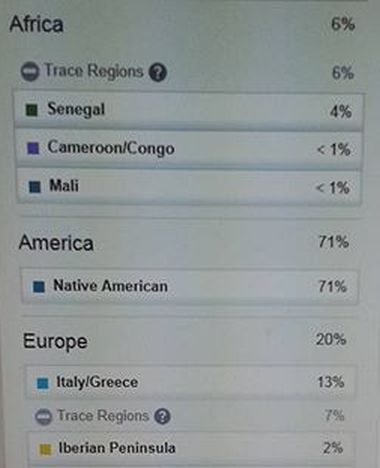
***

***
Also notice the 4% socalled “Central Asian”, no doubt related to the increased level of Native American because of very ancient Siberian connections.
***

***
High “Mali”
***
***
***
***
***

***

***
***
***
High “Southeastern Bantu”
***
***
***
***

***

***
***
***
***
High “North Africa”
***
***
***

***

***
***
***
High “Cameroon/Congo”
***
***
This result displays one the most evenly balanced African breakdowns i have seen sofar for Mexicans.
***

***
High “Ivory Coast/Ghana”
***
***
High “Benin/Togo”
***

***
***

***
***
______________________________________________________________________________
Central American Results
***
Some people might be surprised about the extent of African ancestry found among Central Americans. Because most African admixture took place already several centuries ago it is natural that also many Central Americans themselves might not always be aware of of any African ancesty in their familytree. In the last decades an increasing number of books and articles has been published to shed more light on the African legacy in Central America. Also a number of recent DNA studies has confirmed the generally minor yet widespread amount of African ancestry among Central Americans also those who selfidentify as “Mestizo”. For more references see links below:
- Africanos y afromestizos en la historia colonial de Centroamérica
- Africans and Afro-descendants in Mexico and Central America: overview and challenges of studies of their past and present
- Reconstructing the Population Genetic History of the Caribbean (Hondurans included)
- The genetic ancestry of African, Latino, and European Americans across the United States (based on 23andme results, see this chart for a quick overview)
***
El Salvador
***
Quite diverse breakdown inspite of the minor total African proportion. Aside from the biggest amount of “North Africa”, the Upper Guinean regions of “Senegal” and “Mali” are also noticeably present. Even when in the following results the predominance of especially “Senegal” is greater. The percentages for “Ivory Coast/Ghana” and “Southeastern Bantu” are smaller but still indicative of a wide range of African regional roots and inherited DNA from several African ancestors of different backgrounds.
More details can be read on this highly fascinating blog:
***

***
***
***
A high concentration of “Benin/Togo” being shown in this result below. Still there is also a second Upper Guinean lineage being reported as measured by “Senegal”. It is tempting to assume the “Benin/Togo” % might represent a more recent source of African ancestry because it’s relatively least diluted. But still there are other possible explanations as well.
***
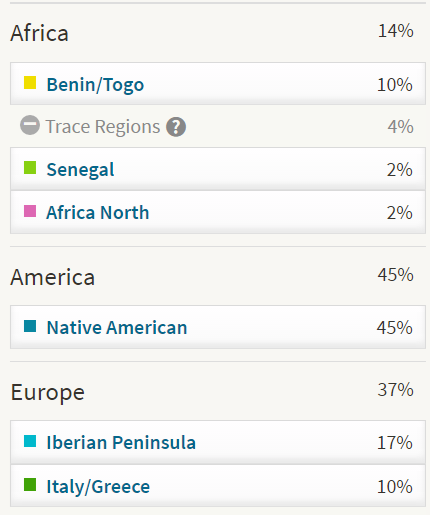
***
Interestingly the person behind the results below is a first cousin of the person whose results were shown directly above. Because of random recombination the DNA segments being shared in between close relatives or even siblings will not be shared in the very same proportions. Still despite a lower amount of total African basically the same two African regional lineages are on display.
***
***

***
Honduras
***

***
This breakdown is quite exceptional in that almost all African ancestry is described in terms of the “Ivory Coast/Ghana” region. It’s very tempting to assume it may hark back to one single African ancestor only. But theoretically it would still be possible that these DNA markers were inherited from several African ancestors (all from the same approximate region) and also along more than just one particular family line.
***
***
***

***
Very evenly balanced scores in the result below.
***

***
This person is only half Honduran, the other half being from Cuba. I imagine such a breakdown could still be seen on many fully Hondurans as well.
***
Guatemala
***
***
***

***

***
This result shows the highest African amount i have seen sofar among Guatemalans. Perhaps not surprisingly this person is from Morales, Izabal departement. Which is located near the Caribbean coast as well as Belize. Suggesting that possibly this person’s African lineage might mostly be of a more recent date (1700’s) than what’s average for Guatemalans from the western part of the country (1500’s/1600’s). It could also suggest a partial Garifuna connection although not per se.
***

***
Costa Rica
This result below shows one of the highest African amounts i have observed sofar for Central Americans. It is known that the Caribbean coastline harbours most self-identified black Central Americans, incl. Garifuna communities. Also many English speaking West Indian migrants, settled here in the early 1900’s. Interestingly this person hails from Puerto Limon, situated right on the Caribbean and home to the greatest number of black or mulatto Costa Ricans, many of them of Jamaican descent (see also Afro-Costa Ricans). I do not know the exact background of this person. His family name as well as his Amerindian & Iberian amounts are confirming his Hispanic origins. However his African breakdown seems to be highly suggestive of atleast a partial West Indian connection. The biggest region being “Ivory Coast/Ghana” but actually also the whole top 3 being very much in line with what i observed among West Indians. See also:
***

______________________________________________________________________________
Colombian Results
***
Some people might be surprised about the extent of African ancestry found among Colombians, especially for those selfidentifying as “Mestizo” and without any connections to the coastal areas (both Caribbean and Pacific) where African ancestry is generally more apparent. Because most African admixture took place already several centuries ago it is natural that also many Colombians themselves might not always be aware of of any distant African ancesty in their familytree. The African presence in Colombia is however well established. For some quick references:
***
This first result features the highest total African amount among Colombians i have observed sofar. As discussed in section 2 it might very well be that Colombians who are of predominant (>50%) African descent might have a different mix of African regions on average than Colombians who are only of minor African descent (<25%).
This person however is somewhere in between, as actually she shows a nearly balanced triracial composition. An outcome which might be quite common for many other Colombians as well. Still the primary region of “Nigeria” seems to indicate African origins dating from a relatively later period (late 1600’s/1700’s) rather than from an earlier period (1500’s/early 1600’s) when Upper Guinean and Angolan origins were more prevalent. Also a very noticeable “North African” score btw.
***

***
This next result is actually from a person who’s half Venezuelan and half Colombian. Interestingly his mother is from Cartagena which functioned as the main entry point of Africans into Colombia and other parts of South America. Still i imagine many Colombians might show similar results. In fact this result resembles the previous screenshot in two aspects:
- a predominant contribution of the socalled Lower Guinea region, represented this time by “Benin/Togo” in addition to “Nigeria”.
- a balanced triracial composition, even more so then the previous result. Almost perfectly one third shares for each continent. With the African amount being only slightly smaller than both the European and Amerindian amounts.
A main difference seems to be the absence of any “Africa North”, which would suggest a greater amount of socalled “Sub Saharan African” origins than shown in the previous result (31% versus 28% (34%-6%). Despite his truly evenly proportioned triracial results this person himself considers himself to be an Afro-Latino, as can be seen in the video below. Very fascinating from a sociological point of view. It seems that self-identification often entails subjective considerations as well aside from objective AncestryDNA results. In this case seemingly having to do with a personal family situation as well as changing racial perceptions due to migration from Colombia to the USA.
***

***
***
***
***
______________________________________________________________________________
South American Results
***
Venezuela
***

***
Bolivia
***

***
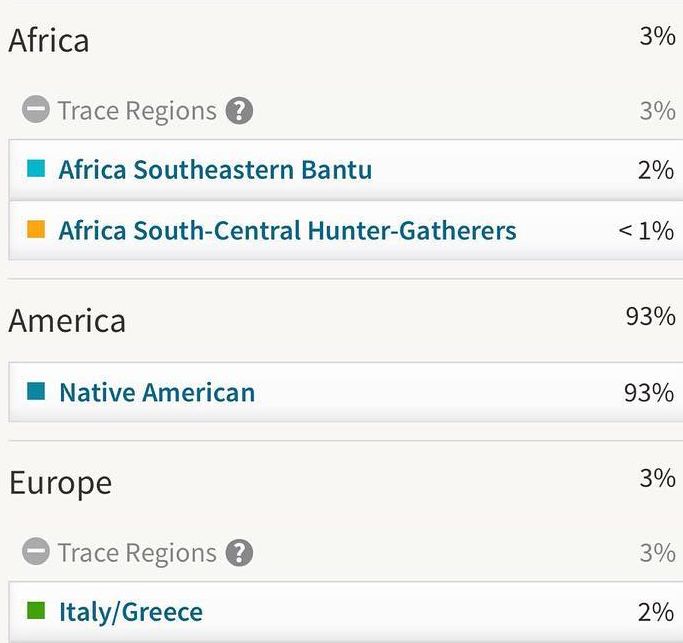
______________________________________________________________________________
Hispanic Results (unspecified/unknown)
***
One of the highest relative “Southeastern Bantu” contribution i have observed sofar (10/12=83%).
***

***
Very similar breakdown, even if less pronounced.
***
***
Possibly of Central American descent but i have no certainty about this person’s background.
***
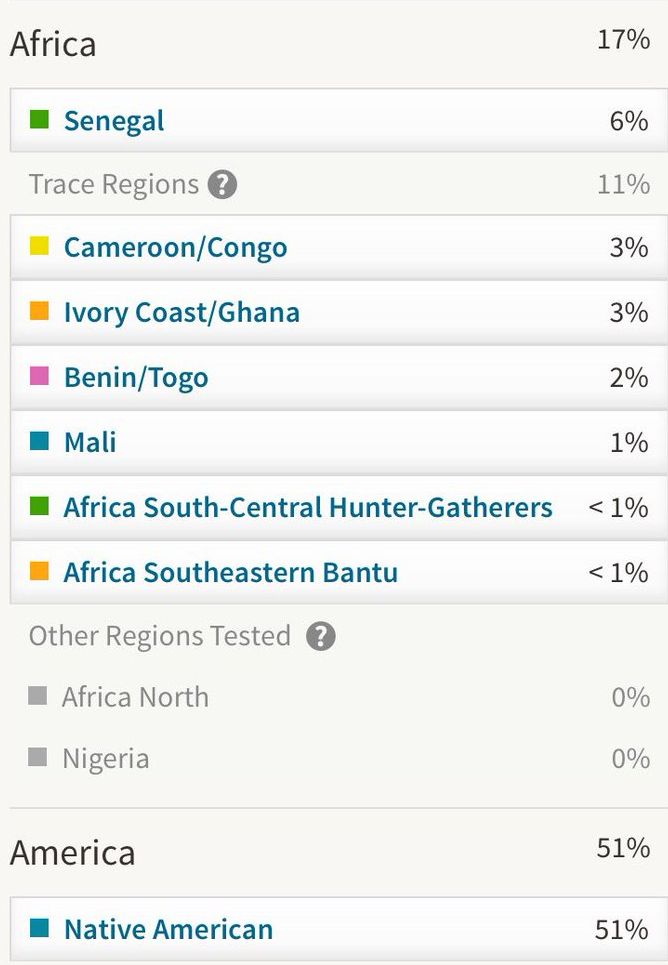
***
Again quite likely either of Mexican or Central American descent. Highly illustrative for the relatively undiluted Upper Guinean lineage many people from that area are reported with by AncestryDNA.

***
______________________________________________________________________________
***
YouTube Results
***
Mexican results
***
***
***
***
El Salvadorean results
***
Honduran results
***
***
***
Colombian results
***
























